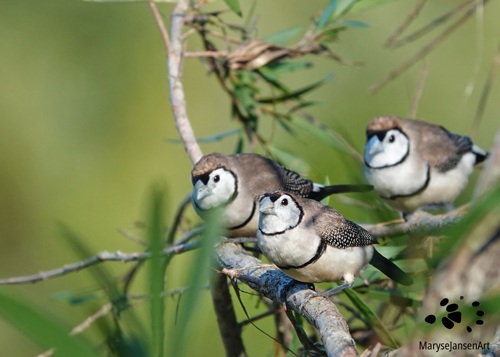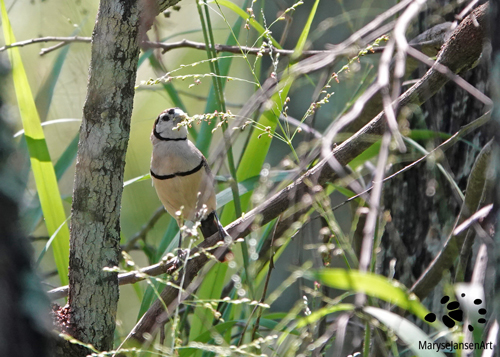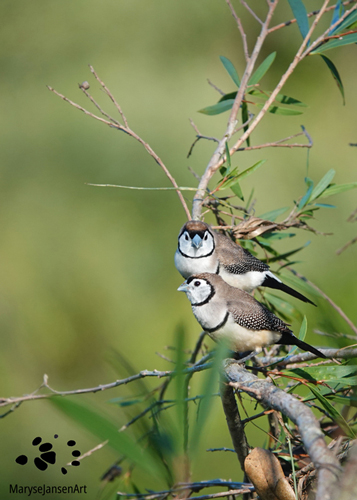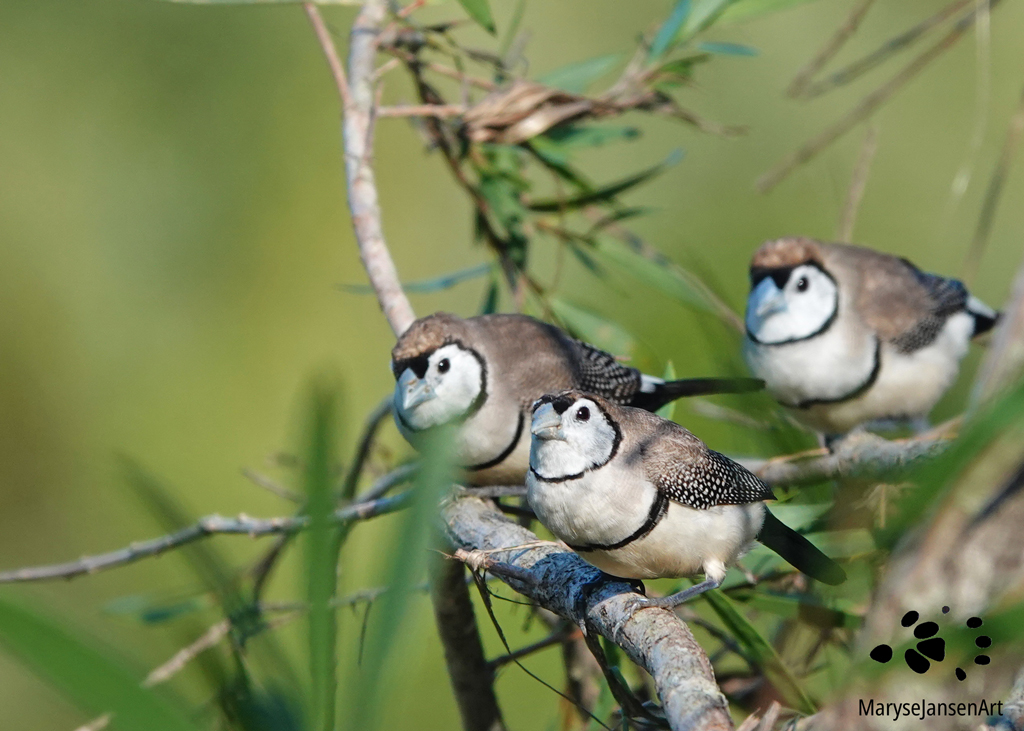Bird Photography with marysejansenart
Always on high alert

The grass is tall, taller than me and I’m not a shortie! I don’t know the name of this grass but I’ve started nick-naming it Elephant Grass. It grows wildly after a bit of rain. It flowers with large plumes and produces lots and lots of seeds. This is what the Double-barred Finches go crazy on.
Double-barred Finch aKa Owl-faced Finch
Double-barred Finches are the cutest little birds, measuring only 10-11cm which includes a fairly long tail! They have a brown back and their white face and underparts are marked with two distinctive black bars. The upper bar extends all the way around their face and gives them an appearance that somewhat resembles a Barn Owl. This explains why they are sometimes called Owl Finch or Owl-faced Finch. Another distinctive feature is their wings which are black, dotted with white spots. Very pretty!
I’m talking about the eastern race here, which is the one I encounter here in eastern Australia. I’ve learned that there is also a western race which lives in northern Australia and has a black rump. Maybe one day I might spot one during my travels, but for now I’ll focus on the eastern race.
On high alert
These finches typically forage in groups of up to 40 birds. When you are small, there is safety in numbers! They are highly alert and at the slightest disturbance, the flock flies up, each bird practicing bouncing, undulating flight patterns which are difficult to predict. Of course they seek cover in the thick undergrowth as quickly as they can.
If you have read my story about the Variegated Fairy-wren, you might be on to the fact that these finches also are challenging to photograph! And unlike the iridescent blue colour of the Fairy-wren that stands out from its surroundings, the colouring of the Double-barred Finches’ plumage has it much more concealed in its environment. So usually it is movement that gives these birds away. They produce a soft “taat-taat-taat” but are usually fairly quiet in my experience.

Double-barred Finches live in open forests, dry grassy woodlands and scrub lands. They need water nearby. The local bush walks and parklands where I regularly go provide the perfect environment for them, and I do spot them there fairly regularly. Most of the time they are either feeding on the ground or close to the ground in the thick vegetation. They mostly feed on seeds and occasionally take insects as well. They are a bit nomadic, following where the seeds are ripe, so I don’t see them all the time.
Over time I’ve managed to get some photos of Double-barred Finches on the ground. I didn’t really like the brown tones of the dirt as a backdrop for these birds though. So one day, when I’m walking in the park on a quiet afternoon I am excited to spot a small group perched in a short tree nearby. I hold still and carefully aim my camera. This is more like it! The afternoon sun lights them up perfectly and their beautiful colours and markings stand out much better against this green backdrop! They are on high alert and ready to take off any moment, hence the title of my featured photo: ‘Ready, Set, Go!’
Double-barred Finches form strong pair bonds

The breeding season of the Double-barred Finches in eastern Australia is during spring and autumn. They are very social birds and when it comes to mating they form very strong pair bonds. The couple creates an enclosed, rounded nest with a tunnel entrance on the side. Soft things like feathers and grass are used to line the inner chamber. A clutch of 4-7 eggs is laid and both parents spend time incubating the eggs, which takes 14 days. Over the next 3 weeks, both parents get busy feeding the chicks until they fledge. Within a year the youngsters are ready to begin breeding themselves.
If you are interested in purchasing ‘Ready, Set, Go!’ or would like to see what the image looks like on the various products, please head to my shop. If you prefer ‘Double-barred Finch Feasting’, click shop here, and for ‘Watching over you’, click shop here.
Check out below the latest episode in my ‘Come for a walk in the Australian Bush’-series, featuring the Double-barred Finch and a number of other birds!


